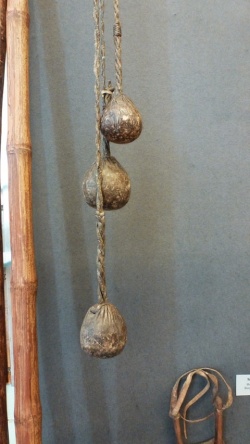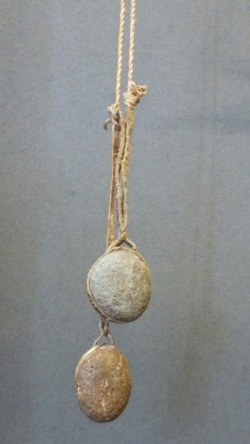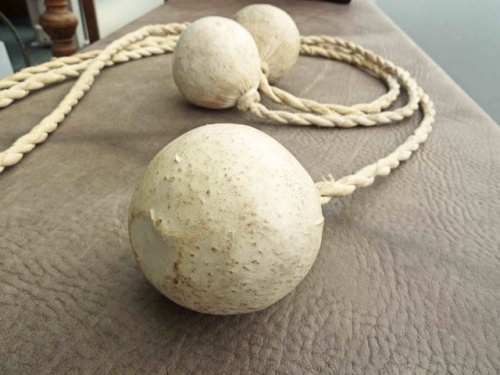Difference between revisions of "Bolas - Boleadoras"
(Created page with "<p align=center> 300px </p> Als '''Bola''' bezeichnet man eine Wurfwaffe der Inuit (sibirische Ureinwohner) sowie der [https://www.youtube.co...") |
|||
| Line 4: | Line 4: | ||
| − | + | ==Bolas - Boleadoras== | |
| + | A Bola or boleadora is a hunting weapon and it is also used for the capture of runaway cattle. Inuit (Siberian aborigines) and [https://www.youtube.com/watch?v=LDmkdFwqTt8&list=PLdGEmp0I4Bawry89Il_c1uc1F7M0Tr7sx South Americans] use it. | ||
| − | + | The Bola consists of two or three lines with a length of 0.4 to 1.5 m each, which are each knotted together at one end to form a star. At the outer end of each line is a weight (stone, leather bag with stones or lead shot). The stones are hold with [[formed leather]] (mostly [[parchment]]) or with [[leather straps]]. | |
| − | + | Use with three balls: One end of the bola is held in the hand and the two other ends are twirled over the head and thrown into the legs of the animal to be caught. This leads to the stumbling and falling of the animal or a riding rider. The rotating bola wraps around the legs of the animal. The goal-oriented litter requires the exercise, since the animal to be caught usually moves quickly. | |
| Line 16: | Line 17: | ||
</p> | </p> | ||
<p align=center> | <p align=center> | ||
| − | ''Bolas | + | ''Bolas in[[formed leather]] and bolas with [[leather straps]].''<br></p> |
<p> </p> | <p> </p> | ||
| Line 23: | Line 24: | ||
</p> | </p> | ||
<p align=center> | <p align=center> | ||
| − | ''Bolas from https://www.youtube.com/watch?v=LDmkdFwqTt8&list=PLdGEmp0I4Bawry89Il_c1uc1F7M0Tr7sx South America].''<br></p> | + | ''Bolas from [https://www.youtube.com/watch?v=LDmkdFwqTt8&list=PLdGEmp0I4Bawry89Il_c1uc1F7M0Tr7sx South America].''<br></p> |
<p> </p> | <p> </p> | ||
Revision as of 20:01, 12 November 2016
Bolas - Boleadoras
A Bola or boleadora is a hunting weapon and it is also used for the capture of runaway cattle. Inuit (Siberian aborigines) and South Americans use it.
The Bola consists of two or three lines with a length of 0.4 to 1.5 m each, which are each knotted together at one end to form a star. At the outer end of each line is a weight (stone, leather bag with stones or lead shot). The stones are hold with formed leather (mostly parchment) or with leather straps.
Use with three balls: One end of the bola is held in the hand and the two other ends are twirled over the head and thrown into the legs of the animal to be caught. This leads to the stumbling and falling of the animal or a riding rider. The rotating bola wraps around the legs of the animal. The goal-oriented litter requires the exercise, since the animal to be caught usually moves quickly.
Bolas informed leather and bolas with leather straps.
Bolas from South America.
Additional information











 a kotori web solution
a kotori web solution